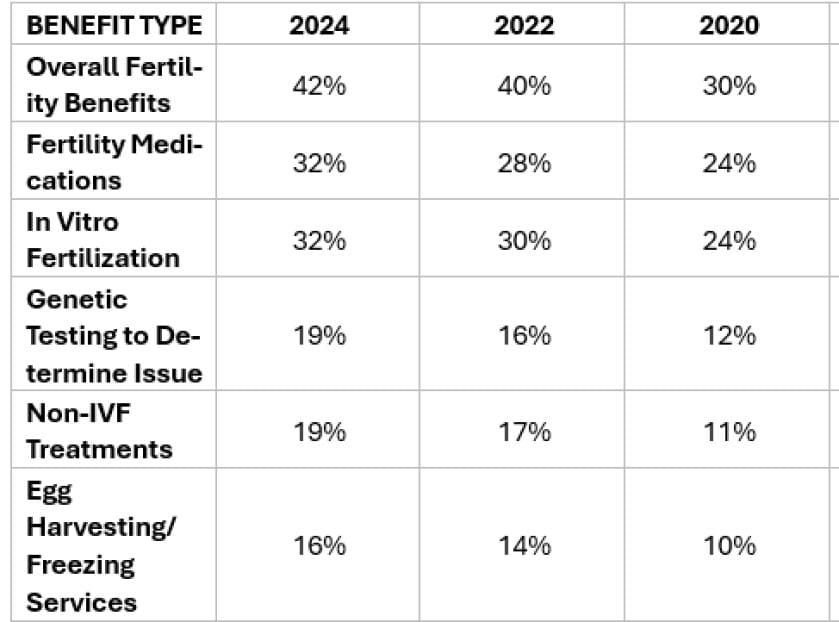As U.S. employers look to bring in talent with inclusive workplaces that center employee needs, more are expanding their benefits portfolios to include fertility-related coverage.
According to a recent survey by the International Foundation of Employee Benefit Plans, 42% of U.S. employers polled offered fertility-related benefits in 2024, up from 30% in 2020.
This uptick comes as more employers consider fertility and family-building benefits imperative business tools. These benefits help employers attract and retain talent and support the overall wellbeing of their workforce, says Julie Stich, vice president of content for the International Foundation of Employee Benefit Plans.
In part, the push to expand fertility benefits may be related to broader attention to employee financial wellness. Fertility treatments can be expensive, often leaving them out of reach for low- to moderate-income employees. A single IVF cycle, for example, may cost upwards of $30,000, with a round of egg freezing costing about $8,000, according to the New York Times. In some instances, employees will take on additional jobs to cover the cost of fertility treatments.
“Employers want to be inclusive and make sure their employees feel valued and believe it’s a great organization to work for,” Stich says.
Here are the areas where employers have increased fertility-related benefit offerings in recent years:

Fertility medications, in-vitro fertilization and non-IVF treatments, such as ovulation-stimulating drugs and intrauterine insemination, posted the largest increases—8 percentage points each—compared to 2020, according to the foundation’s report.
Medications are often a first or preliminary step before fertility treatment, Stich says, adding that employers may be trying to limit costs by covering less expensive measures like medication before moving onto more costly treatments, such as in-vitro fertilization.
New fertility coverage areas
Other trends include organizations wanting to design more inclusive employee benefits offerings, Stich says. “There’s a recognition now amongst employers that families come in all shapes and sizes,” she says.
That includes exploring how fertility benefits can help singles and gay couples build families, such as by covering the cost of sperm freezing and fertility testing, Stich says.
According to a recent Mercer report, 35% of employers offer men’s fertility testing, while 20% of employers cover sperm freezing, and 13% are considering offering men’s sexual health benefits.
Adobe and Cisco, for example, offer their employees financial assistance, regardless of gender, for adoption or surrogacy, as well as sperm, egg and embryo freezing and storage, according to a report by Reproductive Assistance. While these fertility benefits may not be new—sperm freezing has been available since 1952—tailoring programs to include single men and gay couples is relatively new.
Failing to help employees address infertility and family-building challenges can impact employers, Stich warns.
“If an employee is struggling with infertility, adoption delays or the related expenses, their work may suffer in the form of productivity loss, absenteeism or presenteeism,” Stich says. “Offering family-planning benefits can alleviate those stresses while supporting mental and financial wellbeing.”
The post Why more than 40% of U.S. employers now offer fertility benefits appeared first on HR Executive.